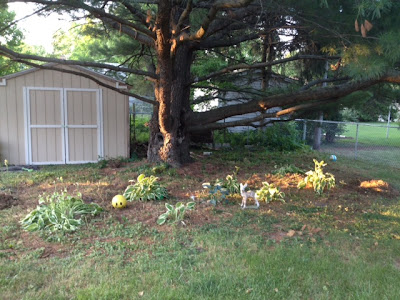Backyard Gardening
 |
| Caya picking and eating our first raspberries |
 |
| Our raised veggie garden |
Our raised vegetable garden is doing really well. I had to put a fence around it since the rabbits were eating the beans, peppers, swiss chard and spinach. The squirrels continue to jump over the fence, into the garden, but I don't really know how to stop that. Ideally, I didn't want to fence in the garden because it makes it less accessible to the girls, but we were starting to lose a lot of our plants. Hopefully, I can take the fence down later in the season once everything is more established.
 |
| Making cilantro cubes |
Community Gardens
One of my favorite things to do in the evening is walk through the community garden in our neighborhood park, Marlborough Park. Someday, when the girls are older, I would love to be part of a community garden. These are pretty large plots and it is definitely a lot of hard work for the families that garden them. Eagle Heights Community Garden is also really interesting to visit. It is located on the west side of the UW-Madison campus, next to the graduate student housing. I believe it one of the oldest and largest community gardens in the country. Since a lot of the graduate students are studying here from abroad, there is a very diverse range of crops planted and gardening styles employed by the gardeners.
Nature-based Outdoor Play
Over the past few weeks I have noticed that the girls, particularly Caya, love to play amongst the plants and under the big tree in our front, shared flower bed. Our neighbor, Kathy, has a bunch of little garden trinkets (plastic and ceramic animals, mushrooms, and other yard ornaments) that she graciously lets the girls move around and play with. Caya can literally spend hours in garden hopping from stepping stone to stepping stone, around and through the plants, in some great imaginative world. She has also become really interested in climbing trees and "swinging from vines" (which is actually her jump rope tied to our play set). In an attempt to entertain the kids our backyard has become filled with structured play equipment (trampoline, play set, sand box, water table). Yet, I should really know better!
 |
| Work in progress - new play area |
My masters work was focused on the development of pro-environmental attitudes in children, and the most important factor was unstructured play time in nature as a child. Then, at work last week I was reviewing a bunch of articles to update the reading material for the teachers that would be participating in this year's Earth Partnership for Schools Institute. Article after article discussed the importance of unstructured play time in nature. The benefits: emotionally, physically, socially, and intellectually are staggering (since this is not an academic article I'm not going to cite sources here, but I am happy to post some articles if anyone is interested). My kids spend a lot of time outdoors, but I started thinking about how the vast majority of our outdoor time is at playgrounds, our yard, or on the sidewalk. Those places are great, but I really want to give them a space to explore, climb, dig and hide (and yes, it is possible they fall, get a scrape, or get poison ivy). Kids love the mystery of not knowing what's around the bend, having little cubbies to hide in, and just watching leaves and clouds. My fondest memories of childhood are of playing in the field and line of large pine trees behind my house. It was probably about 3 or 4 acres of natural space that the neighborhood kids were free to play in without any adult interference. We spent our summers building forts (and tearing down our "enemies" forts), climbing trees, making paths, and eating wild berries.
There is a large pine tree in our backyard that had been accumulating junk from other projects and a lot of thistle plants under it, so it was off-limits for play. With some cleaning up, I decided it would be the perfect "natural" play area for the girls. So far, I've just mowed and raked out all the weeds and thistle and transplanted some hostas and Black-eyed Susan's under the tree, but already Caya and Kili have been back there playing. Ian and I have also been on the look-out for more natural play areas in Madison. A great find is Glenwood Park, it does have some rough terrain and is especially challenging with a 1 yr old who thinks she can just walk off the edge of a stone quarry, but it would be perfect if our kids were older (probably >5 yrs. old).
Finally, this is a great article about the importance of outdoor play, and specifically talks about Glenwood Park. I was introduced to Sam Dennis and his work while I was in graduate school and he was also involved in the watershed curriculum project I just a part of at EPS. Getting Kids to Rediscover the Great Outdoors.

Comments
Post a Comment